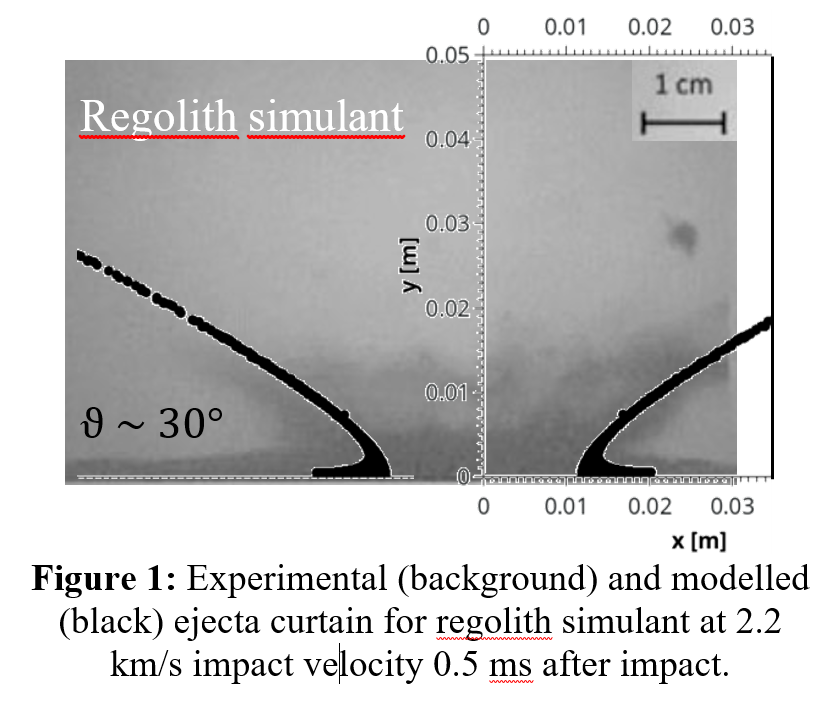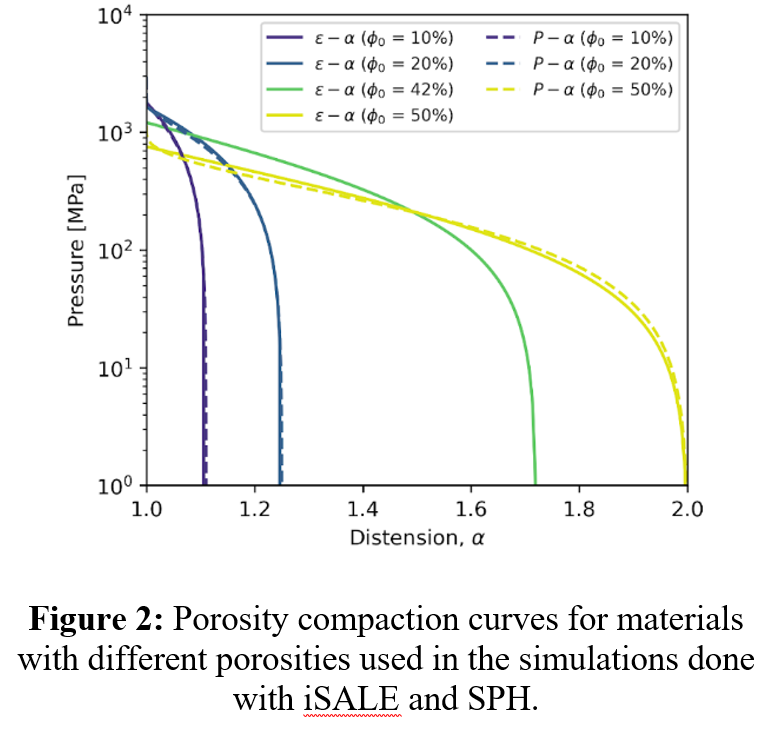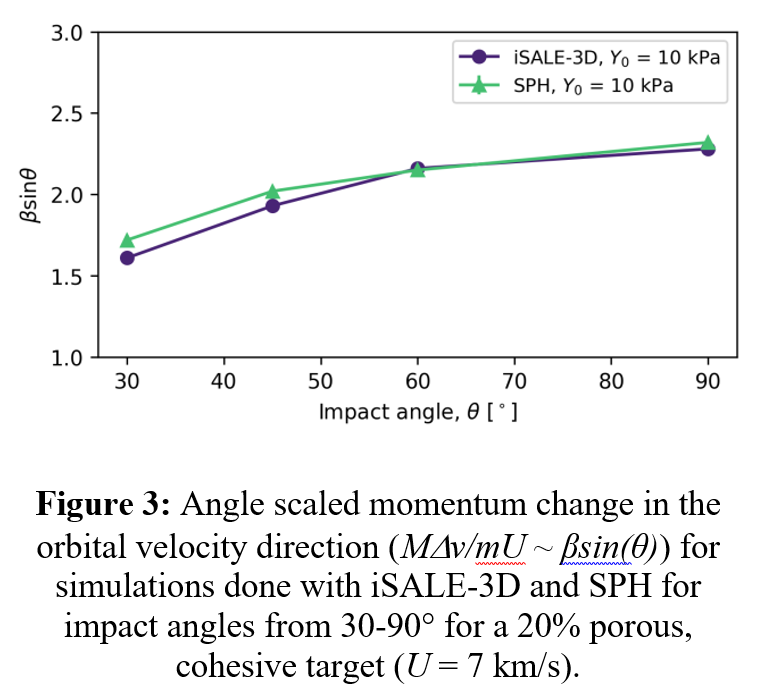Simulating the Momentum Enhancement with iSALE and SPH: An AIDA Benchmark & Validation Study
- 1Museum für Naturkunde Berlin, Berlin, Germany (robert.luther@mfn.berlin)
- 2Space Research and Planetary Sciences, University of Bern, Switzerland
- 3Freie Universität Berlin, Germany
- 4Université Côte d'Azur, Observatoire de la Côte d'Azur, Nice, France
- 5Scientific Support Office, Directorate of Science, European Space Research and Technology Centre (ESA/ESTEC)
- 6LRT / TU Munich, Garching, Germany
- 7Impacts and Astromaterials Research Centre, Imperial College London, UK
- 8Eberhard Karls Universität Tübingen, Germany
1. Introduction
The AIDA international collaboration, which includes the DART (NASA) and Hera (ESA) missions, aims to test the technology of deflection by a kinetic impactor and to enhance our understanding of small bodies in general. In the context of these missions, a spacecraft, DART, will impact the secondary of the 65803 Didymos system, Dimorphos, at the end of October 2022 [1]. The impact will eject asteroid material from the target surface, leading to a measurable change in the orbital period of the binary. A second, follow-up spacecraft, Hera, will arrive at the system several years after the impact to characterize the system and the impact consequences [2].
The objective of this study, which is conducted in the context of the NEO-MAPP project, is to model the collision of the kinetic impactor with Dimorphos and to predict the outcome of the impact with respect to parameters that are measurable by spaceborne and in-situ instrumentation provided by the Hera mission. We model the impact using two different numerical schemes: a continuum approach using iSALE-2D/-3D & a smooth particle approach using Bern SPH. Although all codes solve similar forms of conservation equations and use similar constitutive models, different numerical schemes can produce systematically different results. Hence, as a first step, accurate validation tests against laboratory experiments are conducted to improve the reliability of results from numerical modelling.
2. Method
iSALE-2D/-3D [3, 4] is a grid-based arbitrary Eulerian Lagrangian (ALE) code and is best suited to study crater formation and the propagation of shock waves from a high velocity impact into targets with a variety of different properties. On the other hand, Bern's grid-free Smooth Particle Hydrodynamics (SPH) [5, 6] is most appropriate to study the ejection of material and processes where the entire target body is involved. Both codes include the simulation of material compaction (iSALE: ε-α model; SPH: P-α model) and different strength models. In this study, we employ the Drucker-Prager and the Lundborg rheology models to describe the strength of the material. For both codes, the ejection behaviour is analysed as described in [7,8,9], and the ejection data is used to determine the momentum transferred to the target for deflection (momentum enhancement factor β = ejecta + impactor momentum / impactor momentum). This approach was used previously for systematic parameter studies [9] and benchmarking studies [10]. To validate our shock physics codes, we compare our results against observations from a recent laboratory study [11], where PVC projectiles with a mass of ~25 mg were accelerated to velocities of 1-2 km/s, impacting glass beads, sand and regolith simulant targets. In a second step, we continue the benchmarking work done by the Hera impact working group [12] to detect, assess and remove deviations between two different numerical schemes, iSALE (in 2D and 3D) and Bern SPH at the scale of the DART impact.
3. Validation
We have simulated the crater formation in glass beads and regolith simulant with iSALE-2D at impact speeds of 2.4 km/s and 2.2 km/s, respectively. The glass beads target was modelled using a Drucker-Prager criterion with a coefficient of internal friction, f = 0.5 and an initial porosity of 35%. The regolith simulant used f ~ 0.8 and an initial porosity of 42%. We determine β-values of 2.9 and 1.4, which agree well with experimentally determined values of 2.7 and 1.3, respectively. In the glass beads target laboratory experiment, at ~0.5-1 ms after the impact, the ejecta curtain made an angle of 50-60°. In the case of the regolith simulant, at ~0.5 ms after the impact, the ejecta curtain angle was 30-40°. From our numerical models, we determined ejecta curtain angles 0.5 ms after the impact as 48° (glass beads) and 30° (regolith, Fig. 1). Both results agree with the lower bound of the experimental constraints.

4. Benchmark
The first benchmark study focuses on the influence of target properties on the efficiency of the momentum transfer from the DART impact, β, for materials similar to the regolith simulant. The 600 kg projectile impacts targets with varying porosities, between 10 and 50%, and cohesions from 1 to 100 kPa, at a velocity of 6 km/s. The second benchmark study focuses on the influence of the impact angle on β for the 20% porosity case with 10 kPa cohesion at an impact velocity of 7 km/s.
In previous studies, we found generally good agreement between the results derived with iSALE and SPH [12, 13, 14]. However, for certain porosities the deviations between the results were larger (e.g., 20% porosity and 1 kPa cohesion), which may have been the result of discrepancies in the details of the crush curve used in each model. As a result, here we conducted new models with more consistent crush curves (Fig. 2).

Varying the impact angle for a specific impact scenario and set of target properties shows a remarkably good agreement between the two codes (Fig. 3).

5. Summary
Our joint modelling and experimental approach to study the efficiency of asteroid deflection by a kinetic impactor shows that there is generally a good agreement between different numerical approaches and experimental work. The benchmark studies show that the results from the grid based iSALE (-2D/-3D) and the meshless SPH can deviate for similar initial porosities when the crush curves are not consistent, but they produce similar results when the same impact conditions are considered.
Acknowledgements
We gratefully acknowledge the developers of iSALE (www.isale-code.de). This work has received funding from the European Union’s Horizon 2020 research and innovation programme, NEO-MAPP, grant agreement No. 870377.
References
[1]A.F.Cheng et al.,P&SS157(2018)104-115.
[2]P.Michel et al.,AdvSpaceRes.62(2018)2261-2272.
[3]K.Wünnemann et al.,Icarus180(2006)514–527.
[4]D.Elbeshausen et al.,Icarus204(2009)716–731.
[5]M.Jutzi et al.,Icarus198(2008)242–255.
[6]M.Jutzi,P&SS107(2015)3–9.
[7]M.Jutzi&P.Michel,Icarus229(2014)247-253.
[8]R.Luther et al.,M&PS53(2018)1705–1732.
[9]S.D.Raducan et al.,Icarus329(2019)282–295.
[10]A.Stickle et al.,Icarus338(2020)113446.
[11]S.Chourey et al.,P&SS194(2020)105112.
[12]R.Luther et al.,EPSC-DPS2019-1776(2019).
[13]S.D.Raducan et al.,52th LPSC(2021)#2548id1908.
[14]R.Luther et al.,7th PDC(2021)#122.
How to cite: Luther, R., Raducan, S. D., Jutzi, M., Wünnemann, K., Michel, P., Zhang, Y., Koschny, D., Davison, T. M., Collins, G. S., Schäfer, C., and Burger, C.: Simulating the Momentum Enhancement with iSALE and SPH: An AIDA Benchmark & Validation Study, European Planetary Science Congress 2021, online, 13–24 Sep 2021, EPSC2021-225, https://doi.org/10.5194/epsc2021-225, 2021.

